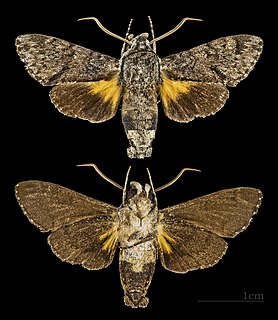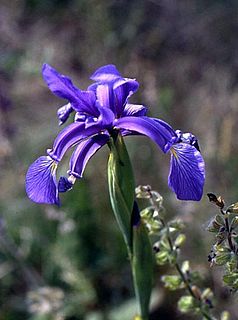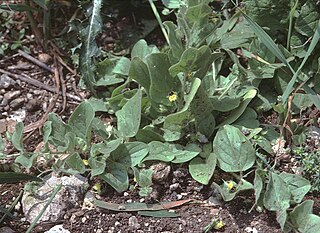Salih Ada is a Turkish island in the Aegean Sea, located north of Bodrum. It is located in the Muğla Province. It is located across Güvercinlik Bay on the Muğla-Bodrum highway. Salih Ada is a popular tourist destination, and is accessible by boat from Bodrum. The hills to the east of the island are covered with pine forest and olive groves.

Cautethia spuria, the spurious sphinx, is a moth of the family Sphingidae. The species was first described by Jean Baptiste Boisduval in 1875. It lives from Mexico to Costa Rica to southern Texas and Oklahoma on the North American continent.

Iris spuria is a species of the genus Iris, part of the subgenus Limniris and the series Spuriae. It is a rhizomatous perennial plant, from Europe, Asia and Africa. It has purple or lilac flowers, and slender, elongated leaves. It is widely cultivated as an ornamental plant in temperate regions and hybridized for use in the garden. It has several subspecies; Iris spuria subsp. carthaliniae B.Mathew, Iris spuria subsp. demetrii B.Mathew, Iris spuria subsp. maritima (Dykes) P.Fourn. and Iris spuria subsp. musulmanica (Fomin) Takht. It used to have 3 other subspecies, which have now been re-classified as separate species; Iris spuria subsp. halophila, Iris spuria ssp. sogdiana and Iris spuria subsp. notha . It has many common names including 'blue iris', 'spurious iris' and 'bastard iris'.

Kickxia spuria is a species of flowering plant in the family Plantaginaceae known by several common names, including roundleaf cancerwort and round-leaved fluellen. It is native to Europe and Asia, but it is present on other continents as an introduced species, and sometimes a noxious weed. This is a low hairy herb with a creeping stem with many branches. It produces rounded, fuzzy leaves at wide intervals along the stem, and solitary snapdragon-like flowers. Each flower is up to 1.5 centimeters long with a narrow, pointed spur extending from the back. The lobes of the mouth are yellow, white, and deep purple, and the whole flower is fuzzy to hairy. The fruit is a spherical capsule about 4 millimeters long. This species is similar to its relative, Kickxia elatine, but for the shape of its leaves, and the hairy flower stalk, which is bare with Kickxia elatine.
The Bare-fronted Hoodwink was a hoax and satirical wastebasket species of bird created by ornithologist M.F.M. Meiklejohn.
Caryanda or Karyanda was a city on the coast of ancient Caria in southwestern Anatolia. Stephanus of Byzantium describes it as a city and harbour (λίμην) near Myndus and Cos. But λιμήν, in the text of Stephanus, is an emendation or alteration: the manuscripts have λίμνη ('lake'). Strabo places Caryanda between Myndus and Bargylia, and he describes it, according to the common text, as "a lake, and island of the same name with it;" and thus the texts of Stephanus, who has got his information from Strabo, agree with the texts of Strabo. Pliny simply mentions the island Caryanda with a town; but he is in that passage only enumerating islands. In another passage he mentions Caryanda as a place on the mainland, and Pomponius Mela does also. Scylax of Caryanda, one of the most famous mariners and explorers of ancient times, was a native of Caryanda. He lived in the late 6th and early 5th centuries BCE and served the Persian king Darius I.

Iris series Spuriae are a series of the genus Iris, in Iris subg. Limniris. They are sometimes commonly known as butterfly irises.

Iris halophila is a species in the genus Iris, it is also in the subgenus Limniris and in series Spuriae. It is a rhizomatous perennial plant, with yellow, white or violet flowers. It is cultivated as an ornamental plant in temperate regions. It comes from a wide range from eastern Europe to China in Asia. It was known for a long while as a subspecies of Iris spuria, before being treated as a separate species in its own right.

Iris spuria subsp. carthaliniae is a species in the genus Iris, it is also in the subgenus of Limniris and in the series Spuriae. It is a subspecies of Iris spuria, a rhizomatous perennial plant, from the Caucasus region, it is a tall iris with sky blue or white flowers. It was originally described by Fomin, as a separate species before Brian Mathew in 1981, added it to Iris spuria as one of its many subspecies. It is cultivated as an ornamental plant in temperate regions.
Iris spuria subsp. demetrii is a species of the genus Iris, part of a subgenus series known as Iris subg. Limniris and in the series Iris ser. Spuriae. It is a subspecies of Iris spuria, a rhizomatous perennial plant, from the Caucasus region, with blue-violet flowers. It is commonly known as Dimitry iris in Russia. It is cultivated as an ornamental plant in temperate regions.

Iris spuria subsp. maritima is a species of the genus Iris, part of a subgenus series known as Iris subg. Limniris and in the series Iris ser. Spuriae. It is a subspecies of Iris spuria, a beardless, rhizomatous perennial plant, from coastal regions Europe and north Africa with deep blue-violet flowers.
Iris spuria subsp. musulmanica is a species of the genus Iris, part of a subgenus known as Limniris and in the series Spuriae. It is a subspecies of Iris spuria and is a rhizomatous perennial plant, from Armenia, Azerbaijan, Iran and Turkey in Asia with flowers in various shades of blue, but there are rare white forms. They have a yellow centre and darker veining. It has the common name of 'Muslim iris'. It is cultivated as an ornamental plant in temperate regions.

Eremophila spuria is a flowering plant in the figwort family, Scrophulariaceae and is endemic to Western Australia. It is an erect, open shrub with narrow leaves and blue, lilac, purple or white flowers and is a common and widespread species.

Caryanda is large genus of grasshoppers in the subfamily Caryandinae. Species are recorded from Africa and Asia.
Caryanda modesta is a species of grasshoppers in the tribe Oxyini, found in the Congo Basin.
Caryanda neoelegans is a species of grasshoppers in the tribe Oxyini, found in Indo-China and eastern China.
Hippodamia sinuata, the sinuate lady beetle, is a species of lady beetle in the family Coccinellidae. It is found in North America and Oceania.
Neapolis or Caryanda Neapolis was a coastal town of ancient Caria. It was located near ancient Myndus and modern Göl. Neapolis was successor of Caryanda, when it was moved early in the 3d century.
Caryanda elegans may refer to:

Balta spuria is a species of cockroach, indigenous to Australia.










